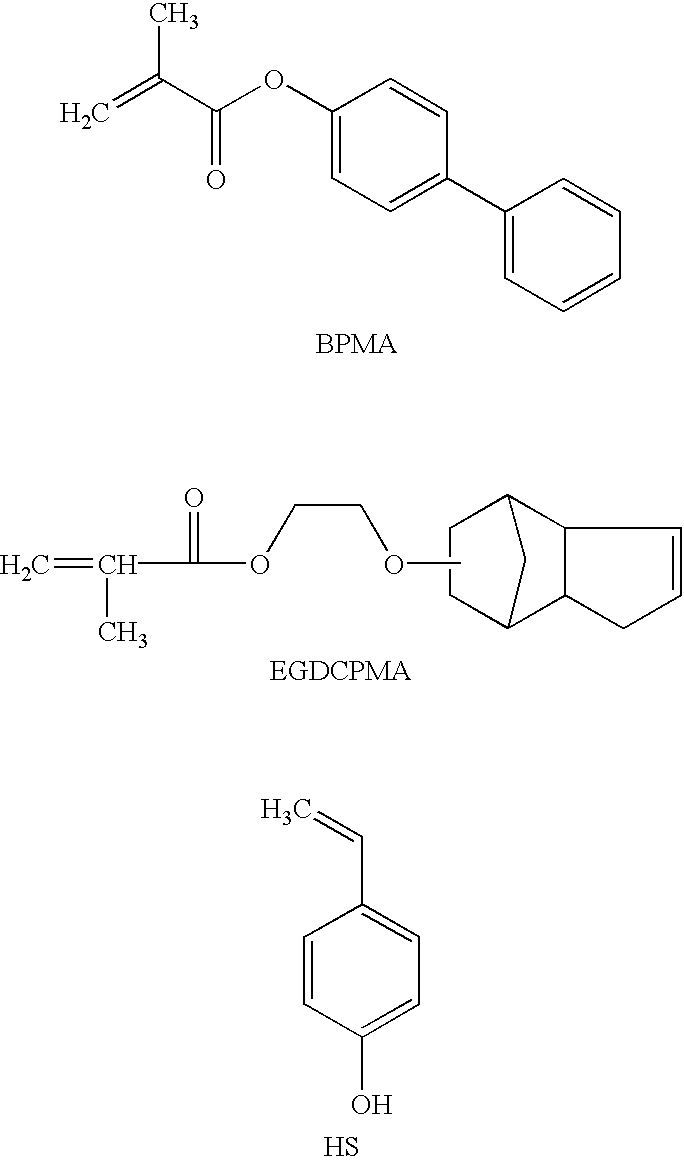Thermally cured underlayer for lithographic application
a technology of lithographic and underlayer, which is applied in the direction of photosensitive materials, instruments, photomechanical equipment, etc., can solve the problems of standing wave effects, too absorbent and insensitive resists used at the higher wavelengths, and reduce resolution
- Summary
- Abstract
- Description
- Claims
- Application Information
AI Technical Summary
Benefits of technology
Problems solved by technology
Method used
Image
Examples
polymer example 1
The mixture of monomers [4-biphenyl methacrylate (72.37 g, 0.303 mol), acetoxy styrene (10.56 g, 0.065 mol) and ethylene glycol dicyclopentenyl ether methacrylate (17.07 g, 0.065 mol)] and initiator VAZO 67 (6.00 g, 6.0 wt % vs monomers) and chain transfer agent 1-dodecanethiol (1.80 g, 30 wt % vs initiator) were polymerized according to the general procedure above. Transesterification employed 4.0 g sodium methoxide solution. Yield: 91.3 g, 94%. M.sub.w =14,666; M.sub.w / M.sub.n =1.92. 5% weight loss at 310.degree. C., Tg: 128.degree. C. composition of polymers, mol %: 69% biphenyl methacrylate units; 16% hydroxystyrene units and 15% ethyleneglycol dicyclopentenyl ether methacrylate units.
polymer example 2
The mixture of monomers [4-biphenyl methacrylate (62.74 g, 0.263 mol), acetoxy styrene (14.23 g, 0.087 mol) and ethylene glycol dicyclopentenyl ether methacrylate (23.03 g, 0.087 mol)] and initiator VAZO 67 (6.00 g, 6.0 wt % vs monomers) and chain transfer agent 1-dodecanethiol (1.80 g, 30 wt % vs initiator) were polymerized according to the general procedure above. Tranesterification employed 5.0 g sodium methoxide solution. Yield: 91.5 g, 95%. M.sub.w =13,715; M.sub.w / M.sub.n =1.97. TGA: 5% weight loss at 305.degree. C.; Tg: 124.degree. C.; composition of polymers, mol %: 60% biphenyl methacrylate units; 19% hydroxystyrene units and 21% ethyleneglycol dicyclopentenyl ether methacrylate units.
polymer example 3
The mixture of monomers [4-biphenyl methacrylate (54.09 g, 0.227 mol), acetoxy styrene (22.09 g, 0.136 mol) and ethylene glycol dicyclopentenyl ether methacrylate (23.82 g, 0.09 mol)] and initiator VAZO 67 (6.00 g, 6.0 wt % vs monomers) and chain transfer agent 1-dodecanethiol (1.80 g, 30 wt % vs initiator) were polymerized according to the general procedure above. Transesterification employed 6.0 g sodium methoxide solution. Yield: 85.5 g, 91%. M.sub.w =11,262 / 1.88; M.sub.w / M.sub.n =1.88; TGA: 5% weight loss at 300.degree. C.; Tg: 118.degree. C. composition of polymers, mol %: 51% biphenyl methacrylate units; 28% hydroxystyrene units and 21% ethyleneglycol dicyclopentenyl ether methacrylate units.
PUM
| Property | Measurement | Unit |
|---|---|---|
| wavelength | aaaaa | aaaaa |
| wavelength | aaaaa | aaaaa |
| temperatures | aaaaa | aaaaa |
Abstract
Description
Claims
Application Information
 Login to View More
Login to View More - R&D
- Intellectual Property
- Life Sciences
- Materials
- Tech Scout
- Unparalleled Data Quality
- Higher Quality Content
- 60% Fewer Hallucinations
Browse by: Latest US Patents, China's latest patents, Technical Efficacy Thesaurus, Application Domain, Technology Topic, Popular Technical Reports.
© 2025 PatSnap. All rights reserved.Legal|Privacy policy|Modern Slavery Act Transparency Statement|Sitemap|About US| Contact US: help@patsnap.com



